Workflow Analysis of Appointment Scheduling with EHR Integration
VerifiedAdded on 2023/06/12
|9
|1874
|139
Report
AI Summary
This report provides a workflow analysis of appointment scheduling within a healthcare setting, emphasizing the integration of Electronic Health Records (EHR). It identifies key processes, from initial patient contact and registration to clinical examination preparation. The analysis uses a flowchart to visually represent the workflow, highlighting areas for improvement such as implementing touch screen input devices and mobile apps for demographic data collection, as well as automated systems for measuring vital signs. Metrics like checklists are suggested to measure workflow soundness. The report concludes by stressing the importance of awareness regarding activity flow for effective resource utilization and waste minimization. Desklib provides this and other solved assignments for students.
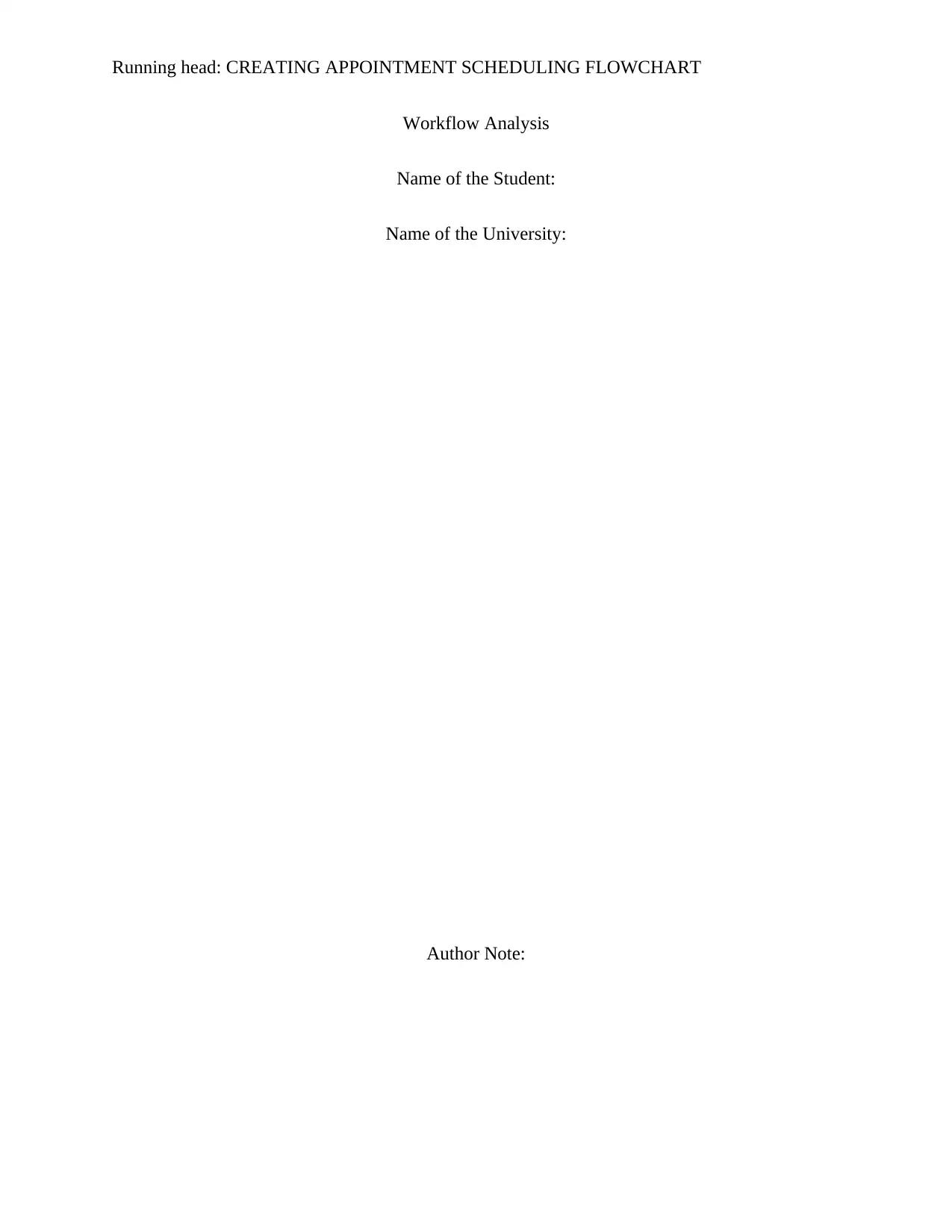
Running head: CREATING APPOINTMENT SCHEDULING FLOWCHART
Workflow Analysis
Name of the Student:
Name of the University:
Author Note:
Workflow Analysis
Name of the Student:
Name of the University:
Author Note:
Paraphrase This Document
Need a fresh take? Get an instant paraphrase of this document with our AI Paraphraser
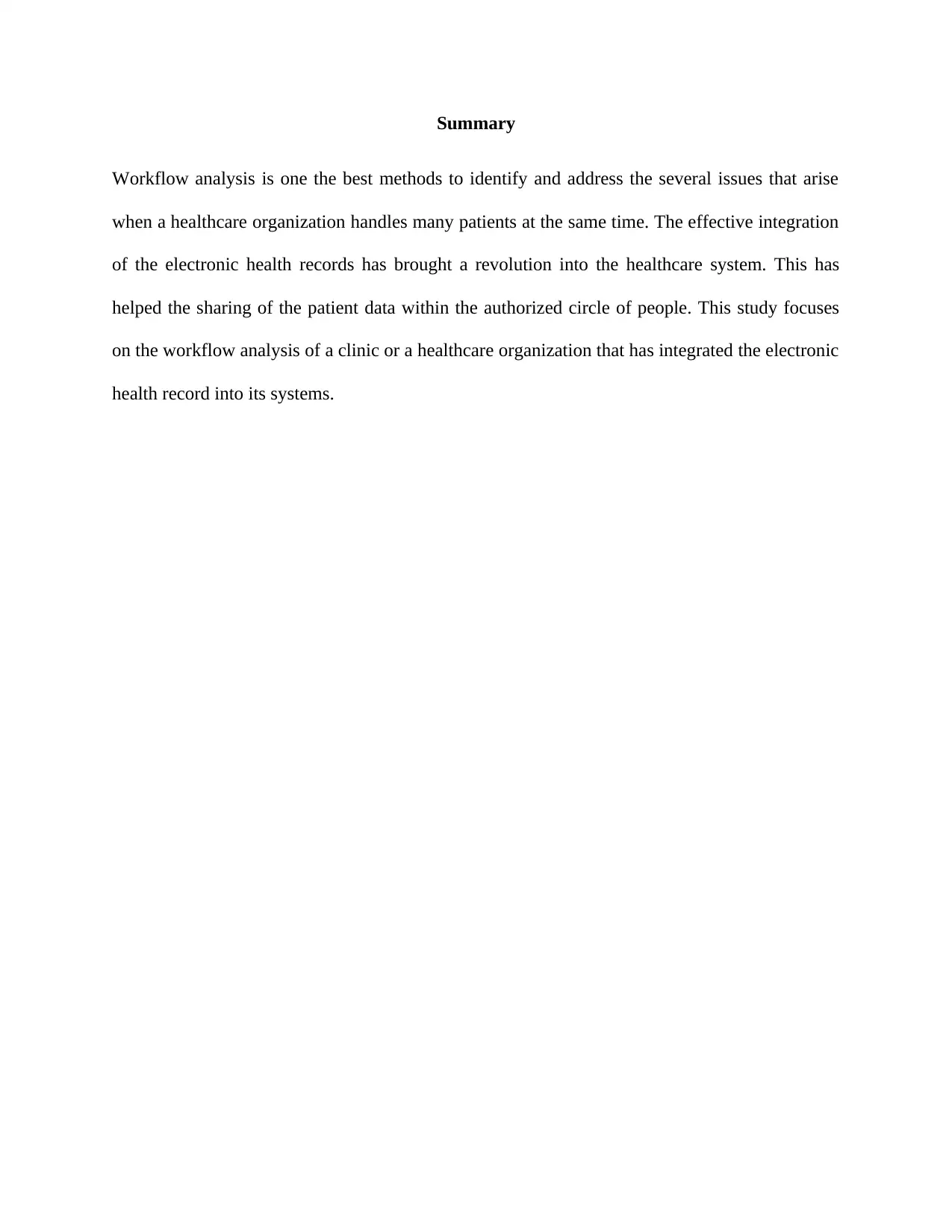
Summary
Workflow analysis is one the best methods to identify and address the several issues that arise
when a healthcare organization handles many patients at the same time. The effective integration
of the electronic health records has brought a revolution into the healthcare system. This has
helped the sharing of the patient data within the authorized circle of people. This study focuses
on the workflow analysis of a clinic or a healthcare organization that has integrated the electronic
health record into its systems.
Workflow analysis is one the best methods to identify and address the several issues that arise
when a healthcare organization handles many patients at the same time. The effective integration
of the electronic health records has brought a revolution into the healthcare system. This has
helped the sharing of the patient data within the authorized circle of people. This study focuses
on the workflow analysis of a clinic or a healthcare organization that has integrated the electronic
health record into its systems.
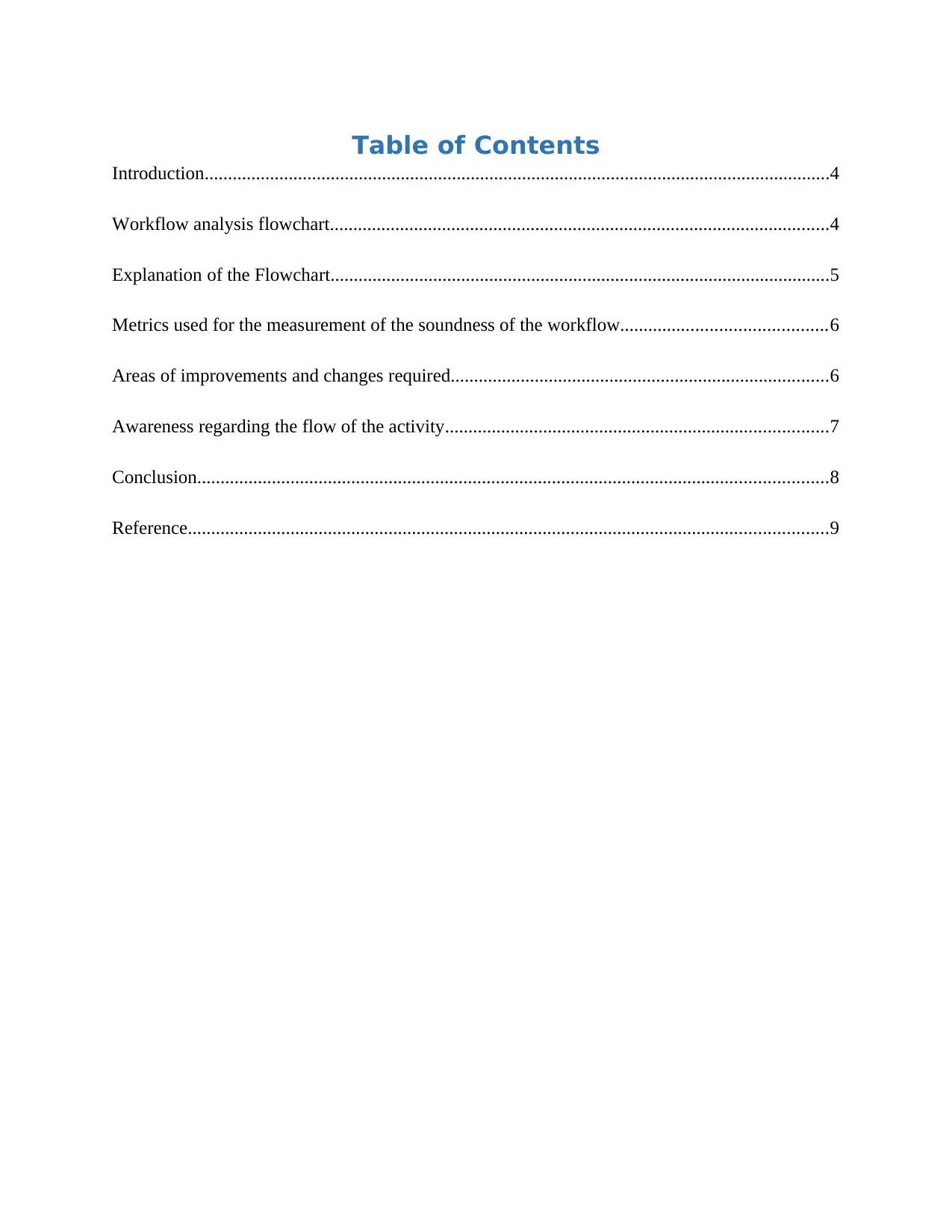
Table of Contents
Introduction......................................................................................................................................4
Workflow analysis flowchart...........................................................................................................4
Explanation of the Flowchart...........................................................................................................5
Metrics used for the measurement of the soundness of the workflow............................................6
Areas of improvements and changes required.................................................................................6
Awareness regarding the flow of the activity..................................................................................7
Conclusion.......................................................................................................................................8
Reference.........................................................................................................................................9
Introduction......................................................................................................................................4
Workflow analysis flowchart...........................................................................................................4
Explanation of the Flowchart...........................................................................................................5
Metrics used for the measurement of the soundness of the workflow............................................6
Areas of improvements and changes required.................................................................................6
Awareness regarding the flow of the activity..................................................................................7
Conclusion.......................................................................................................................................8
Reference.........................................................................................................................................9
⊘ This is a preview!⊘
Do you want full access?
Subscribe today to unlock all pages.

Trusted by 1+ million students worldwide
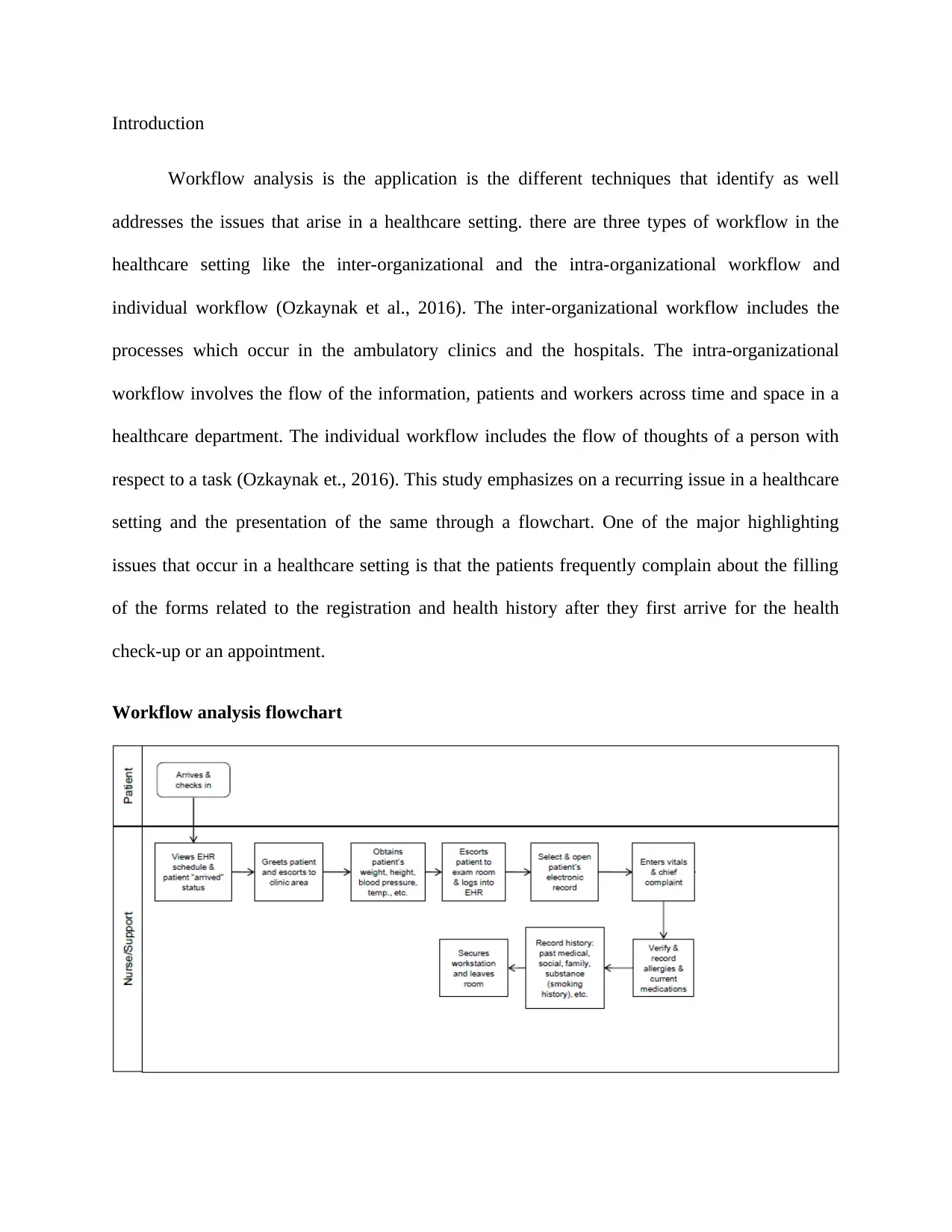
Introduction
Workflow analysis is the application is the different techniques that identify as well
addresses the issues that arise in a healthcare setting. there are three types of workflow in the
healthcare setting like the inter-organizational and the intra-organizational workflow and
individual workflow (Ozkaynak et al., 2016). The inter-organizational workflow includes the
processes which occur in the ambulatory clinics and the hospitals. The intra-organizational
workflow involves the flow of the information, patients and workers across time and space in a
healthcare department. The individual workflow includes the flow of thoughts of a person with
respect to a task (Ozkaynak et., 2016). This study emphasizes on a recurring issue in a healthcare
setting and the presentation of the same through a flowchart. One of the major highlighting
issues that occur in a healthcare setting is that the patients frequently complain about the filling
of the forms related to the registration and health history after they first arrive for the health
check-up or an appointment.
Workflow analysis flowchart
Workflow analysis is the application is the different techniques that identify as well
addresses the issues that arise in a healthcare setting. there are three types of workflow in the
healthcare setting like the inter-organizational and the intra-organizational workflow and
individual workflow (Ozkaynak et al., 2016). The inter-organizational workflow includes the
processes which occur in the ambulatory clinics and the hospitals. The intra-organizational
workflow involves the flow of the information, patients and workers across time and space in a
healthcare department. The individual workflow includes the flow of thoughts of a person with
respect to a task (Ozkaynak et., 2016). This study emphasizes on a recurring issue in a healthcare
setting and the presentation of the same through a flowchart. One of the major highlighting
issues that occur in a healthcare setting is that the patients frequently complain about the filling
of the forms related to the registration and health history after they first arrive for the health
check-up or an appointment.
Workflow analysis flowchart
Paraphrase This Document
Need a fresh take? Get an instant paraphrase of this document with our AI Paraphraser
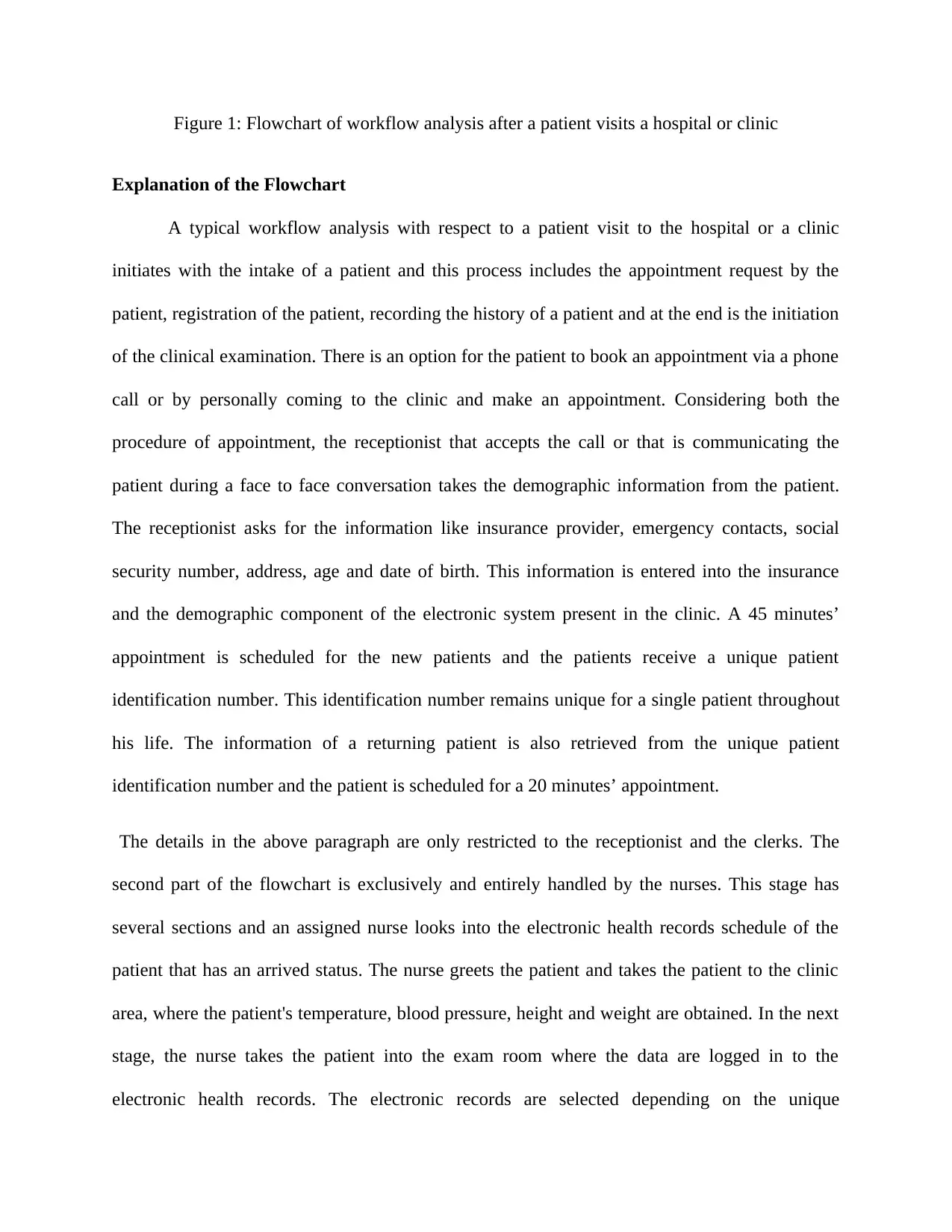
Figure 1: Flowchart of workflow analysis after a patient visits a hospital or clinic
Explanation of the Flowchart
A typical workflow analysis with respect to a patient visit to the hospital or a clinic
initiates with the intake of a patient and this process includes the appointment request by the
patient, registration of the patient, recording the history of a patient and at the end is the initiation
of the clinical examination. There is an option for the patient to book an appointment via a phone
call or by personally coming to the clinic and make an appointment. Considering both the
procedure of appointment, the receptionist that accepts the call or that is communicating the
patient during a face to face conversation takes the demographic information from the patient.
The receptionist asks for the information like insurance provider, emergency contacts, social
security number, address, age and date of birth. This information is entered into the insurance
and the demographic component of the electronic system present in the clinic. A 45 minutes’
appointment is scheduled for the new patients and the patients receive a unique patient
identification number. This identification number remains unique for a single patient throughout
his life. The information of a returning patient is also retrieved from the unique patient
identification number and the patient is scheduled for a 20 minutes’ appointment.
The details in the above paragraph are only restricted to the receptionist and the clerks. The
second part of the flowchart is exclusively and entirely handled by the nurses. This stage has
several sections and an assigned nurse looks into the electronic health records schedule of the
patient that has an arrived status. The nurse greets the patient and takes the patient to the clinic
area, where the patient's temperature, blood pressure, height and weight are obtained. In the next
stage, the nurse takes the patient into the exam room where the data are logged in to the
electronic health records. The electronic records are selected depending on the unique
Explanation of the Flowchart
A typical workflow analysis with respect to a patient visit to the hospital or a clinic
initiates with the intake of a patient and this process includes the appointment request by the
patient, registration of the patient, recording the history of a patient and at the end is the initiation
of the clinical examination. There is an option for the patient to book an appointment via a phone
call or by personally coming to the clinic and make an appointment. Considering both the
procedure of appointment, the receptionist that accepts the call or that is communicating the
patient during a face to face conversation takes the demographic information from the patient.
The receptionist asks for the information like insurance provider, emergency contacts, social
security number, address, age and date of birth. This information is entered into the insurance
and the demographic component of the electronic system present in the clinic. A 45 minutes’
appointment is scheduled for the new patients and the patients receive a unique patient
identification number. This identification number remains unique for a single patient throughout
his life. The information of a returning patient is also retrieved from the unique patient
identification number and the patient is scheduled for a 20 minutes’ appointment.
The details in the above paragraph are only restricted to the receptionist and the clerks. The
second part of the flowchart is exclusively and entirely handled by the nurses. This stage has
several sections and an assigned nurse looks into the electronic health records schedule of the
patient that has an arrived status. The nurse greets the patient and takes the patient to the clinic
area, where the patient's temperature, blood pressure, height and weight are obtained. In the next
stage, the nurse takes the patient into the exam room where the data are logged in to the
electronic health records. The electronic records are selected depending on the unique
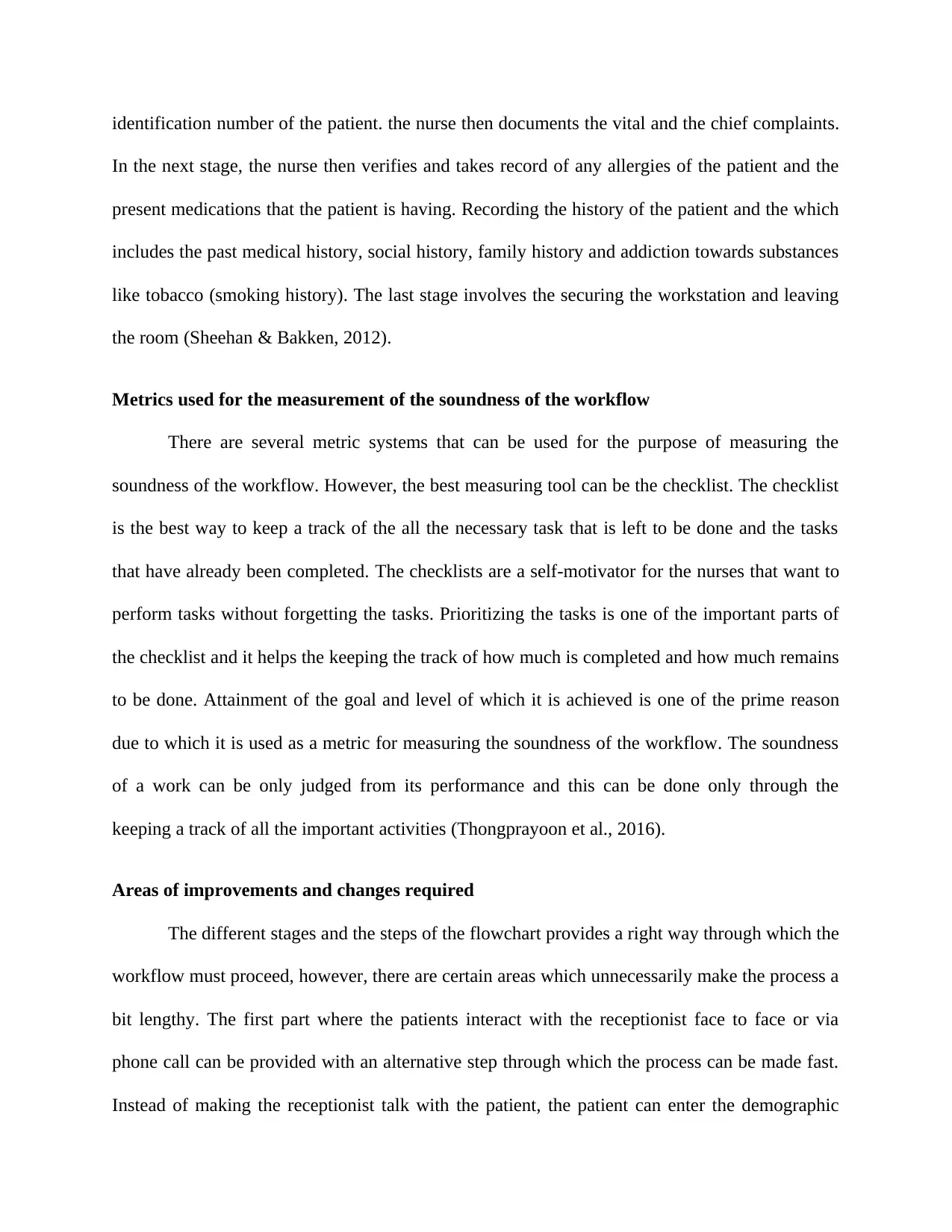
identification number of the patient. the nurse then documents the vital and the chief complaints.
In the next stage, the nurse then verifies and takes record of any allergies of the patient and the
present medications that the patient is having. Recording the history of the patient and the which
includes the past medical history, social history, family history and addiction towards substances
like tobacco (smoking history). The last stage involves the securing the workstation and leaving
the room (Sheehan & Bakken, 2012).
Metrics used for the measurement of the soundness of the workflow
There are several metric systems that can be used for the purpose of measuring the
soundness of the workflow. However, the best measuring tool can be the checklist. The checklist
is the best way to keep a track of the all the necessary task that is left to be done and the tasks
that have already been completed. The checklists are a self-motivator for the nurses that want to
perform tasks without forgetting the tasks. Prioritizing the tasks is one of the important parts of
the checklist and it helps the keeping the track of how much is completed and how much remains
to be done. Attainment of the goal and level of which it is achieved is one of the prime reason
due to which it is used as a metric for measuring the soundness of the workflow. The soundness
of a work can be only judged from its performance and this can be done only through the
keeping a track of all the important activities (Thongprayoon et al., 2016).
Areas of improvements and changes required
The different stages and the steps of the flowchart provides a right way through which the
workflow must proceed, however, there are certain areas which unnecessarily make the process a
bit lengthy. The first part where the patients interact with the receptionist face to face or via
phone call can be provided with an alternative step through which the process can be made fast.
Instead of making the receptionist talk with the patient, the patient can enter the demographic
In the next stage, the nurse then verifies and takes record of any allergies of the patient and the
present medications that the patient is having. Recording the history of the patient and the which
includes the past medical history, social history, family history and addiction towards substances
like tobacco (smoking history). The last stage involves the securing the workstation and leaving
the room (Sheehan & Bakken, 2012).
Metrics used for the measurement of the soundness of the workflow
There are several metric systems that can be used for the purpose of measuring the
soundness of the workflow. However, the best measuring tool can be the checklist. The checklist
is the best way to keep a track of the all the necessary task that is left to be done and the tasks
that have already been completed. The checklists are a self-motivator for the nurses that want to
perform tasks without forgetting the tasks. Prioritizing the tasks is one of the important parts of
the checklist and it helps the keeping the track of how much is completed and how much remains
to be done. Attainment of the goal and level of which it is achieved is one of the prime reason
due to which it is used as a metric for measuring the soundness of the workflow. The soundness
of a work can be only judged from its performance and this can be done only through the
keeping a track of all the important activities (Thongprayoon et al., 2016).
Areas of improvements and changes required
The different stages and the steps of the flowchart provides a right way through which the
workflow must proceed, however, there are certain areas which unnecessarily make the process a
bit lengthy. The first part where the patients interact with the receptionist face to face or via
phone call can be provided with an alternative step through which the process can be made fast.
Instead of making the receptionist talk with the patient, the patient can enter the demographic
⊘ This is a preview!⊘
Do you want full access?
Subscribe today to unlock all pages.

Trusted by 1+ million students worldwide
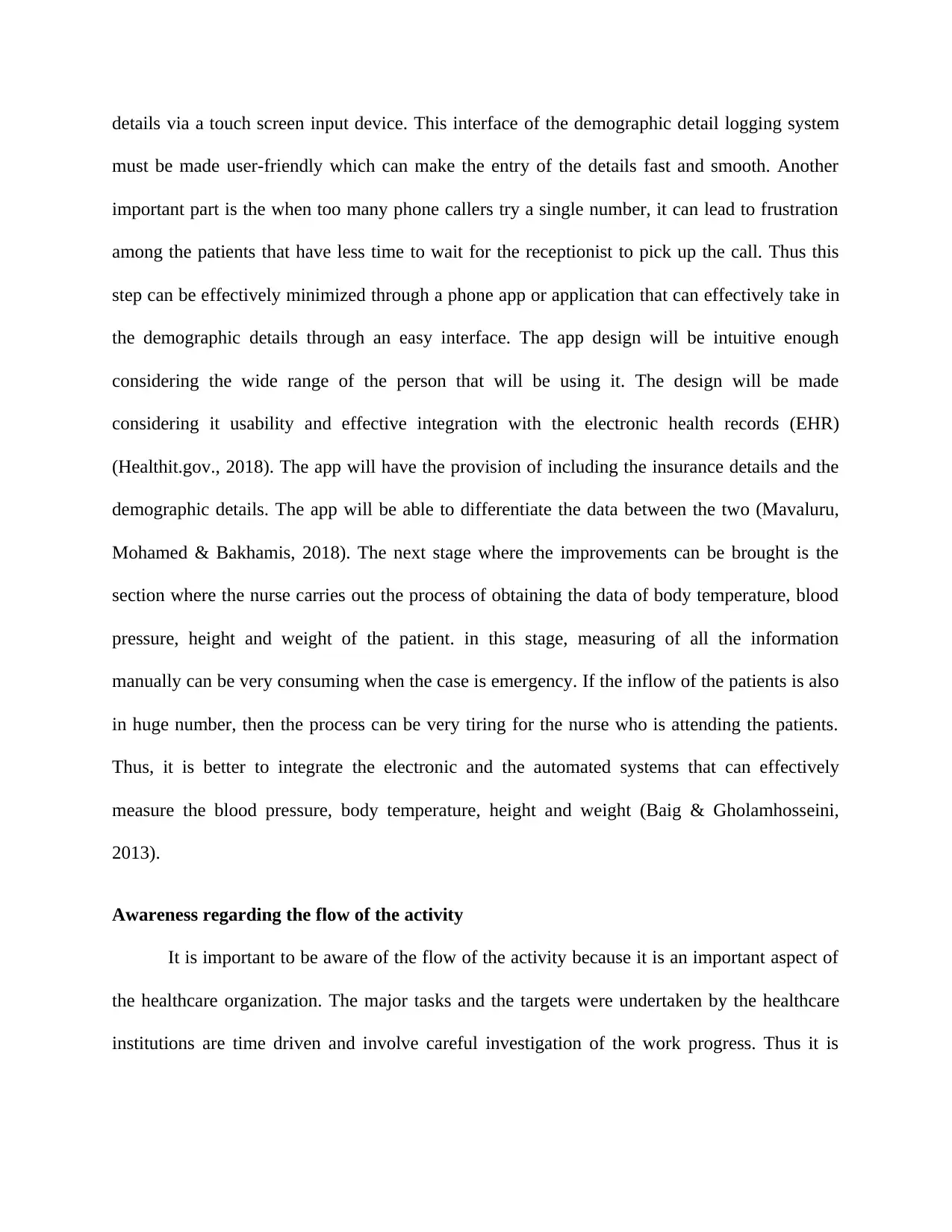
details via a touch screen input device. This interface of the demographic detail logging system
must be made user-friendly which can make the entry of the details fast and smooth. Another
important part is the when too many phone callers try a single number, it can lead to frustration
among the patients that have less time to wait for the receptionist to pick up the call. Thus this
step can be effectively minimized through a phone app or application that can effectively take in
the demographic details through an easy interface. The app design will be intuitive enough
considering the wide range of the person that will be using it. The design will be made
considering it usability and effective integration with the electronic health records (EHR)
(Healthit.gov., 2018). The app will have the provision of including the insurance details and the
demographic details. The app will be able to differentiate the data between the two (Mavaluru,
Mohamed & Bakhamis, 2018). The next stage where the improvements can be brought is the
section where the nurse carries out the process of obtaining the data of body temperature, blood
pressure, height and weight of the patient. in this stage, measuring of all the information
manually can be very consuming when the case is emergency. If the inflow of the patients is also
in huge number, then the process can be very tiring for the nurse who is attending the patients.
Thus, it is better to integrate the electronic and the automated systems that can effectively
measure the blood pressure, body temperature, height and weight (Baig & Gholamhosseini,
2013).
Awareness regarding the flow of the activity
It is important to be aware of the flow of the activity because it is an important aspect of
the healthcare organization. The major tasks and the targets were undertaken by the healthcare
institutions are time driven and involve careful investigation of the work progress. Thus it is
must be made user-friendly which can make the entry of the details fast and smooth. Another
important part is the when too many phone callers try a single number, it can lead to frustration
among the patients that have less time to wait for the receptionist to pick up the call. Thus this
step can be effectively minimized through a phone app or application that can effectively take in
the demographic details through an easy interface. The app design will be intuitive enough
considering the wide range of the person that will be using it. The design will be made
considering it usability and effective integration with the electronic health records (EHR)
(Healthit.gov., 2018). The app will have the provision of including the insurance details and the
demographic details. The app will be able to differentiate the data between the two (Mavaluru,
Mohamed & Bakhamis, 2018). The next stage where the improvements can be brought is the
section where the nurse carries out the process of obtaining the data of body temperature, blood
pressure, height and weight of the patient. in this stage, measuring of all the information
manually can be very consuming when the case is emergency. If the inflow of the patients is also
in huge number, then the process can be very tiring for the nurse who is attending the patients.
Thus, it is better to integrate the electronic and the automated systems that can effectively
measure the blood pressure, body temperature, height and weight (Baig & Gholamhosseini,
2013).
Awareness regarding the flow of the activity
It is important to be aware of the flow of the activity because it is an important aspect of
the healthcare organization. The major tasks and the targets were undertaken by the healthcare
institutions are time driven and involve careful investigation of the work progress. Thus it is
Paraphrase This Document
Need a fresh take? Get an instant paraphrase of this document with our AI Paraphraser
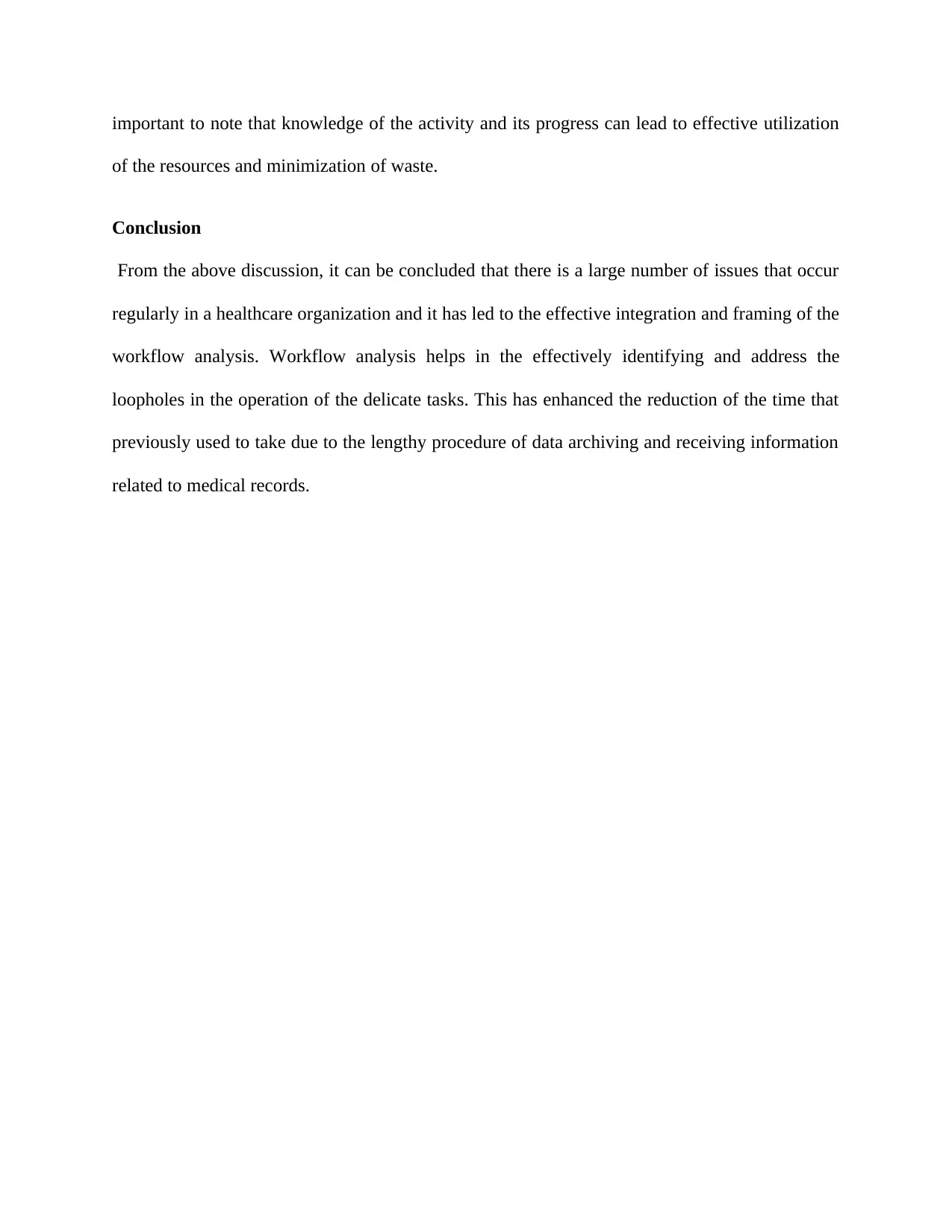
important to note that knowledge of the activity and its progress can lead to effective utilization
of the resources and minimization of waste.
Conclusion
From the above discussion, it can be concluded that there is a large number of issues that occur
regularly in a healthcare organization and it has led to the effective integration and framing of the
workflow analysis. Workflow analysis helps in the effectively identifying and address the
loopholes in the operation of the delicate tasks. This has enhanced the reduction of the time that
previously used to take due to the lengthy procedure of data archiving and receiving information
related to medical records.
of the resources and minimization of waste.
Conclusion
From the above discussion, it can be concluded that there is a large number of issues that occur
regularly in a healthcare organization and it has led to the effective integration and framing of the
workflow analysis. Workflow analysis helps in the effectively identifying and address the
loopholes in the operation of the delicate tasks. This has enhanced the reduction of the time that
previously used to take due to the lengthy procedure of data archiving and receiving information
related to medical records.
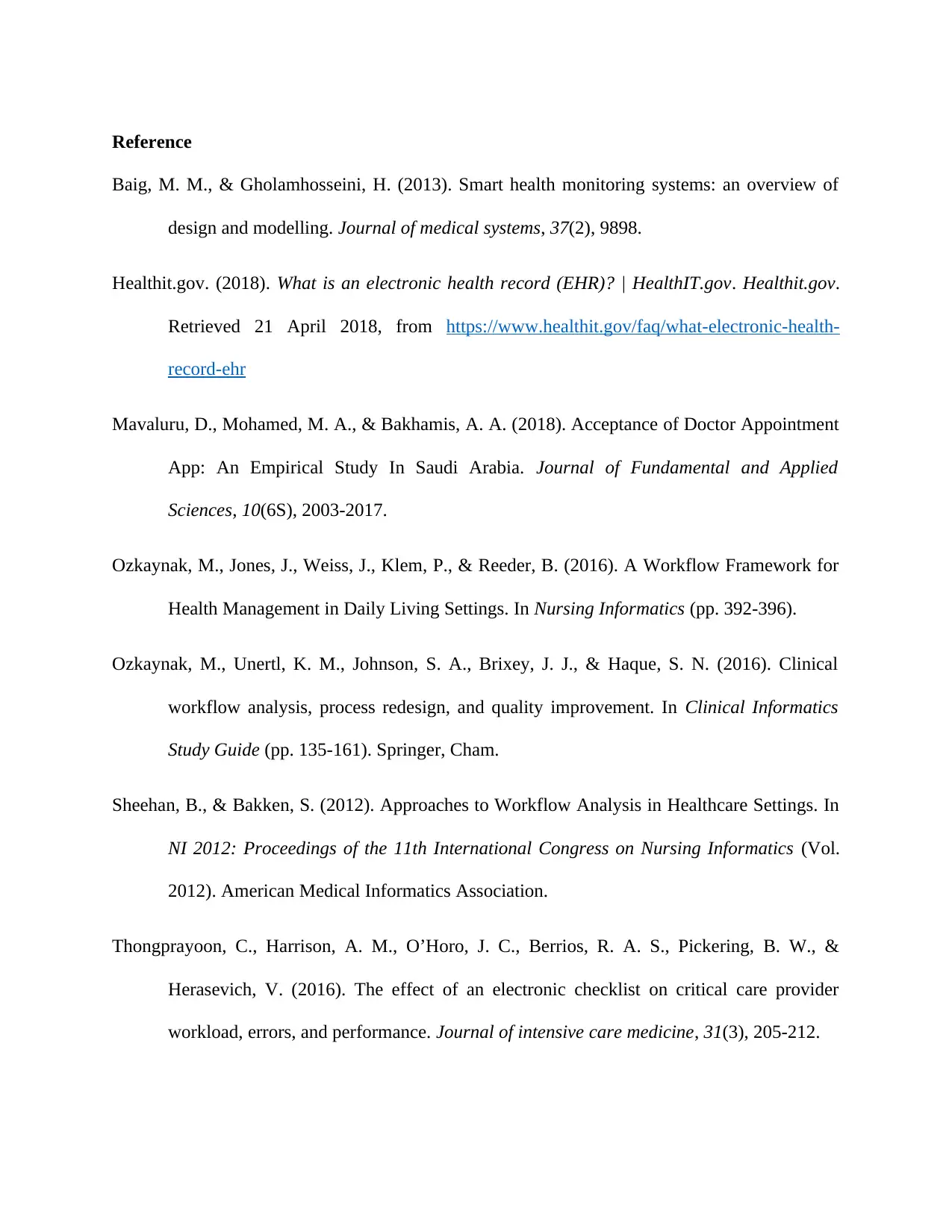
Reference
Baig, M. M., & Gholamhosseini, H. (2013). Smart health monitoring systems: an overview of
design and modelling. Journal of medical systems, 37(2), 9898.
Healthit.gov. (2018). What is an electronic health record (EHR)? | HealthIT.gov. Healthit.gov.
Retrieved 21 April 2018, from https://www.healthit.gov/faq/what-electronic-health-
record-ehr
Mavaluru, D., Mohamed, M. A., & Bakhamis, A. A. (2018). Acceptance of Doctor Appointment
App: An Empirical Study In Saudi Arabia. Journal of Fundamental and Applied
Sciences, 10(6S), 2003-2017.
Ozkaynak, M., Jones, J., Weiss, J., Klem, P., & Reeder, B. (2016). A Workflow Framework for
Health Management in Daily Living Settings. In Nursing Informatics (pp. 392-396).
Ozkaynak, M., Unertl, K. M., Johnson, S. A., Brixey, J. J., & Haque, S. N. (2016). Clinical
workflow analysis, process redesign, and quality improvement. In Clinical Informatics
Study Guide (pp. 135-161). Springer, Cham.
Sheehan, B., & Bakken, S. (2012). Approaches to Workflow Analysis in Healthcare Settings. In
NI 2012: Proceedings of the 11th International Congress on Nursing Informatics (Vol.
2012). American Medical Informatics Association.
Thongprayoon, C., Harrison, A. M., O’Horo, J. C., Berrios, R. A. S., Pickering, B. W., &
Herasevich, V. (2016). The effect of an electronic checklist on critical care provider
workload, errors, and performance. Journal of intensive care medicine, 31(3), 205-212.
Baig, M. M., & Gholamhosseini, H. (2013). Smart health monitoring systems: an overview of
design and modelling. Journal of medical systems, 37(2), 9898.
Healthit.gov. (2018). What is an electronic health record (EHR)? | HealthIT.gov. Healthit.gov.
Retrieved 21 April 2018, from https://www.healthit.gov/faq/what-electronic-health-
record-ehr
Mavaluru, D., Mohamed, M. A., & Bakhamis, A. A. (2018). Acceptance of Doctor Appointment
App: An Empirical Study In Saudi Arabia. Journal of Fundamental and Applied
Sciences, 10(6S), 2003-2017.
Ozkaynak, M., Jones, J., Weiss, J., Klem, P., & Reeder, B. (2016). A Workflow Framework for
Health Management in Daily Living Settings. In Nursing Informatics (pp. 392-396).
Ozkaynak, M., Unertl, K. M., Johnson, S. A., Brixey, J. J., & Haque, S. N. (2016). Clinical
workflow analysis, process redesign, and quality improvement. In Clinical Informatics
Study Guide (pp. 135-161). Springer, Cham.
Sheehan, B., & Bakken, S. (2012). Approaches to Workflow Analysis in Healthcare Settings. In
NI 2012: Proceedings of the 11th International Congress on Nursing Informatics (Vol.
2012). American Medical Informatics Association.
Thongprayoon, C., Harrison, A. M., O’Horo, J. C., Berrios, R. A. S., Pickering, B. W., &
Herasevich, V. (2016). The effect of an electronic checklist on critical care provider
workload, errors, and performance. Journal of intensive care medicine, 31(3), 205-212.
⊘ This is a preview!⊘
Do you want full access?
Subscribe today to unlock all pages.

Trusted by 1+ million students worldwide
1 out of 9
Related Documents
Your All-in-One AI-Powered Toolkit for Academic Success.
+13062052269
info@desklib.com
Available 24*7 on WhatsApp / Email
![[object Object]](/_next/static/media/star-bottom.7253800d.svg)
Unlock your academic potential
Copyright © 2020–2025 A2Z Services. All Rights Reserved. Developed and managed by ZUCOL.





